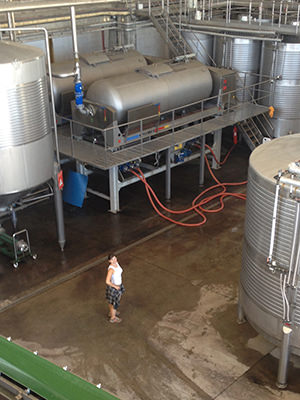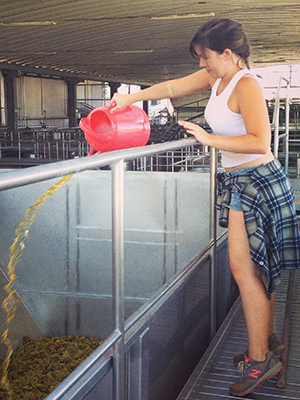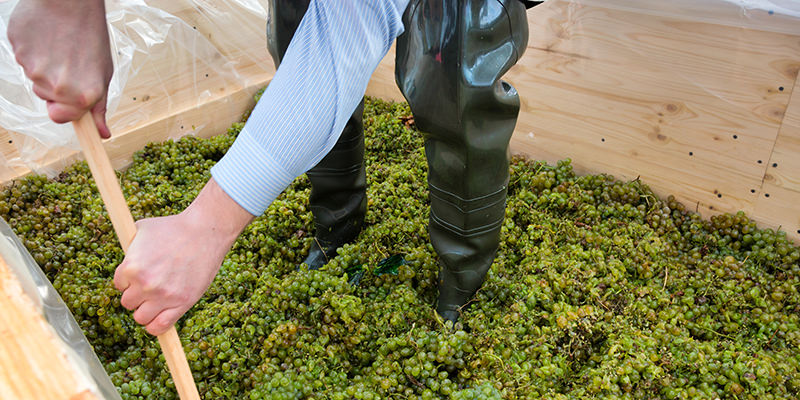I arrived in Lisbon on a cloudless August afternoon, and the warm Iberian sun created that magical type of day where everyone is nice and anything seems possible. With a 50-pound pack on my back and hope in my heart, I anticipated what I was certain would be the adventure of a lifetime.
This is the story of how it wasn’t.
I was in Portugal for the start of vindima, or wine harvest, an experience I’d been looking forward to all year. Growing up in a Portuguese enclave in Massachusetts I had long been familiar with the tiny nation’s lush red and lightly sparkling white wines, and even knew a few key phrases to get by in rural towns where English speakers rarely wander.
I’d discovered Spur winery–the actual name of the winery has been changed to protect confidentiality– early in my drinking days, just after I began chronicling my bottle-hitting habits online. Spur’s entry-level whites retail under $10 in the U.S., making them an ideal choice for a young lady with a college student budget and bartender’s thirst looking to hone her palate.
Through said honing, a few blog posts, and several advantageous friendships I’d been accepted as a harvest intern at Spur, and had now arrived in Lisbon ready to pick grapes, crush them with my feet, embody a summer-camp-meets-college attitude and get paid for it for twelve weeks. “Working Harvest” is the wine professionals’ equivalent to earning pilot’s wings, with the hands-on, down-and-dirty experience known for pushing writers, sommeliers, and salespeople to the next-level, and adding an impressive line to any resume. I was ready for the challenge, and the adventure.
A short bus met me and the other interns at the train station deep in the Alentejo region of Southeastern Portugal on Monday morning. The 6 of us (3 English speakers, 3 Spanish speakers) were quite the crew–some were dressed for work in boots and pants, other wore short-shorts and were ready for a kegger.
Alentejo is a vast, arid region that encompasses nearly a third of Portugal’s landmass. Golden, rolling hills dotted with ancient olive and cork trees cover the landscape, which is best known for robust, quaffable red wines from Tempranillo (known locally as Arragones) and a flood of indigenous grapes. Spur is one of the largest wineries in the region, with a great reputation for producing reliable, and thoroughly enjoyable wines at prices that can’t be beat.
Off we went after our arrival–no work today, just a tour of the winery that would soon be home. Out from the olive groves and desert-like scrub rose an imposing structure–industrial revolution meets Oz. First, a massive and exquisitely carved white stone tower appeared on a hill before us (“Wow, we’ll be working there!” I thought naively). As we bounced in the minibus to take the best pictures, the functional side of the winery came into view: a massive cement and metal fortress from which enormous tanks shot skyward, clearly unfettered by the laws that keep most European buildings to 3 or 4 stories.
Guided by Spur’s winemakers, we explored the colossal facility. First, thousands of kilos of grapes fell into gigantic metal hoppers where their skins were broken, stems ripped away, and the remaining juice pumped through steel and glass pipes for upwards of 100 yards, to pumps, presses, and tanks to settle and begin their magical transformation into vinho.
We toured the facility’s expensive lab, gorgeous tasting room, and underground caves with wonder, awestruck at their sheer size, and fantasized about the inspiring jobs we were about to have. We would be making wine, and we were responsible for every step, from receiving fruit to stomping grapes in marble vats fit to be Marie Antoinette’s bathtub. “Plus, that will double as great exercise! “ I thought, “We’ll be so tanned and slender, Portugal will be the best.”
Reality met me at the door of the rented apartment where we would be living. Nestled down a discreet cobblestone road in a charming village, the apartment seemed promising. “I’ll leave you all here to unpack and get settled,” said our boss, or patrão. “There’s some beds to put together, and later I’ll take you to the store.”
In we went with proverbial bells on. The bed frames were all broken. Linens, kitchen tools, and hot water were absent. Furniture was limited to a broken TV and a table sans chairs. Water mysteriously flowed into the hallway from a bathroom without light fixtures. Live wires poked through the walls. Toilet seats were a luxury we did not possess.
“It’s all part of the charm,” said one of our workmates, “Let’s just get some beer.”
And we did. Over several 40-packs of Sagres–Southern Portugal’s equivalent to Budweiser–we decided to be in love with our little hovel, chairs or no chairs, and eventually got the hot water hooked up to a dangerous-looking tank of propane. Trading cold showers for the danger of our apartment exploding didn’t seem so bad at the time.
Promptly at 7:30 am all six of us climbed back aboard the minibus that drove us and 20 other workers from our picturesque village to the winery. Elated would be an understatement to describe our moods–we were positively ecstatic about starting work. Would we be tasting the fermentations already going on?! Running the huge wine presses?! Stomping grapes with our feet?!
Having studied wine for several years at this point, I thought I knew what harvest time entailed. In most wine books, even those designed for beverage professionals, the process is simple and wonderful:
- Pick beautifully ripe grapes, preferably by hand, during the morning.
- Sort out any debris or damaged grapes so only the best fruit enters the blend.
- Crush the grapes mechanically or with your feet, and put the juice into barrels or tanks.
- Fermentation starts and wine is made.
This careful process sounded magical–human labor is hardly needed for the marvelous transformation of grapes to wine. Being thoroughly familiar with Spur’s PR materials, I was certain we’d simply be edging the enchantment of fermentation along.
This was another instance where I was dead wrong, and it didn’t take me long to figure it out.
Upon arriving on the minibus, the patrão led us through the busy red winemaking area to a large concrete room, lined with shelves and piled full of colossal bags of powder. Along the only empty wall sat a large scale and a pile of clear plastic bags.
The powder was sulfur, the infamous element that everyone loves to hate, yet is present in nearly all winemaking–proclaimed “organic” or not. Whether added before, during, or after initial winemaking, sulfur prevents wine from oxidizing prematurely, and doubly kills harmful bacteria that cause funky, “off” flavors in wines. Sulfur and the sulfides they produce are naturally present in lots of food products, like orange juice and prosciutto, but wine seems to inspire the most conflict surrounding this smelly chemical. Of course, in high concentrations sulfur can also cause blindness, difficulty breathing, and burn your skin off.
Seated on the chemical room’s dusty cement floor armed with plastic cups and latex gloves, we started in on the day’s work: measuring and bagging powdered sulfur. 2,000 bags at 140 grams; 976 bags at 960 grams; 5 bags at 2,000 grams—counting, measuring, and coughing we made it through our first two days. “Well,” I thought, “ I haven’t learned much about wine, but I have learned what it must feel like to process cocaine.”
When we finally finished our butt-numbing days on the concrete floor, the group was split between red and white winemaking. Happy to end up on the white side with a good friend and fellow English speaker, we took our positions at the top of the hoppers with pride, ready to be the liaison between white grapes and the winery. Little did we know that this job would continue to expose our cluelessness and disillusion with winemaking.
Our new post first involved mixing our favorite substance–powdered sulfur–with water 100 liters at a time, releasing a noxious, gag-inducing cloud (YUM!). Next, tractors pulling huge loads of grapes would arrive, and with a thunderous roar 10,000 pounds of grapes would plummet into the hopper in addition to sticks, leaves, spiders and countless other bits of debris. Luckily we learned that with enough chemicals, sticks and stones won’t destroy a wine.
We would start by dousing the grapes with liters of sulfur, annihilating any bacteria and yeast that naturally coat white grapes like Arinto and Antao Vaz, the refreshing white staples of Alentejo wine. Next, we would add citric acid, to help overripe, low-acid grapes yield a bright and refreshing wine. We then poured curious, smelly cups of brown enzymes over the grapes to ensure a healthy fermentation. In short, we killed first and asked questions later, encouraging only the exact bacteria Spur wanted in its wines.

My days on the hopper–which alternated between bacteria extermination and sprinting samples up and down the stairs to the lab–were sadly not the end of my winemaking woes.
Once most of the fruit had arrived (or our superiors thought we looked too depressed to keep accepting fruit) we had the job of inoculating must, or unfermented grape juice, with yeast to initiate fermentation. Yeast in action is extremely cool – it bubbles and hisses and is truly alive. What isn’t cool is adding “aroma smoothers,” “color extractors,” and “powdered protein hulls,” which all smell like peanut butter and have bizarre warnings on the labels.
The bonus with inoculation duty? 30-minute breaks while the yeast wake up, and the knowledge that with one wrong turn of a valve or pump, you will be doused in sticky-sweet grape must the way contestants on old school Nickelodeon shows were slimed. I know because it happened repeatedly, turning 100-degree desert days into syrupy 100-degree days complete with clouds of flies.
As the 12-hour days rolled into 72-hour work weeks that left little time for study abroad-style diversions, I had an epiphany: winemaking is hard work, and the romanticism that surrounds the wine industry is partly concocted by clever marketers. They’re the same marketers that claim pizza is a vegetable and make industrial meat-farming seem humane.
There was no magic in these carefully-timed fermentations, or Spur’s bottlings in the supermarket which retailed from 2 Euro to 40 Euro per bottle. What did exist was exacting science, complicated testing, and formula upon formula. Vindima was nothing like the Under the Tuscan Sun romance I’d been promised. Instead, it was like making Coca-Cola or Twinkies, an exacting sequence of processes that produce a consistent product. Nobody expects the Hostess factory to be romantic, or soda production to be charming, so why do we expect it from wine producers?
This rude awakening smacked me in the face one sweaty afternoon, and I haven’t looked back since. Knowing what goes on behind glossy, well-designed labels and wine scores hasn’t stopped me from enjoying Spur or other inexpensive, mass-produced wines. In fact, I still drink and write about them often.
Day by day the harvest dragged on–chemicals, oak chips, barrel filling, barrel emptying–and one day I slipped. Slipped right down an infamous set of red steel stairs, severely spraining my wrist and winning the title of “1st Intern to Experience a Rural Emergency Room.” My superiors couldn’t have been more generous with my time off, or the Port they gave me in unlabeled bottles to numb the physical and emotional pain of being trapped in our toilet-seat-free abode with only one hand all day long.
One tumble, lots of confusion, and a few X-rays later, my harvest was over. Departure was bittersweet–anyone who tells you that working 12-hour days is fun is either lying or masochistic. In fact, I’ve come to learn that even small winemakers don’t consider harvest “romantic” or “adventurous.” Those I know have called it “grueling” and “stressful.”
And while many elements of my Alentejo harvest were hellish, I wouldn’t trade my experience for any number of press trips or winery tours, where glamour is on the menu. My harvest wasn’t a fairytale experience. It was a real, sticky, life-shaping, opinion-forming, hand-staining affair, and it proved one thing: winemaking is not sexy. It is not fun. It is not an easy, simple job.
If you want easy and fun, read the shelf-talkers at wine stores, and take classes–hell, teach classes–for budding oenophiles that involve lots of tasting. Drink wine and enjoy it everyday. Appreciate it. Most importantly, know that winemakers aren’t elusive sorcerers who make wine with a flick of the wrist from some balcony, but hardworking chemists who are crazy enough to inhale harmful chemicals and forgo weekends for months so we can all drink. God knows I couldn’t do it.

